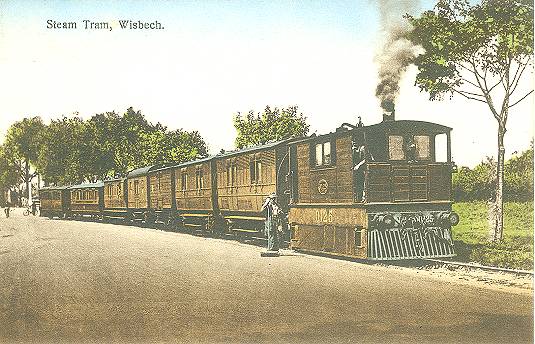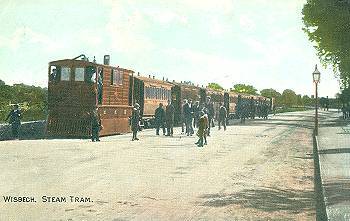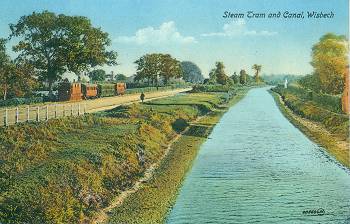

Our main postcard shows a train of the Wisbech and Upwell tramway at Elm Road, Wisbech in Cambridgeshire. It was produced by an unknown publisher around 1905. The smaller view below is number 23289 in a series by another unknown publisher, possibly the same one. Our copy of this was posted in 1906. It is at the same location as the main view but is looking in the opposite direction. In both cases the Wisbech Canal is lower and out of sight behind the trains. The final view, Valentine's Series card 80360, is a little further along the line near New Common Bridge and shows both canal and the roadside steam tramway.
The Well Stream had been made navigable since the early 14th century but by the late 15th century had silted up. The channel was re-dug and in 1797 the canal opened connecting the River Nene near Wisbech with the Well Creek at Outwell. There were tidal locks at each end. Commercial traffic dwindled with the opening of the tramway and the last commercial craft passed through in 1922. It was officially closed on 14th June 1926 but remained derelict until the 1960s when it was filled in for road building and landfill.
 The Wisbech and Upwell tramway was built by the Great Eastern Railway (GER) and the first section from Wisbech East GER station to Outwell Basin opened on 20th August 1883 with a one and a half mile extension to Upwell Depot opening on 8th September the following year, bringing the total line length to just under six miles. On the Cambridgeshire/Norfolk border, the standard gauge line was mostly on a roadside reservation following the route of the canal. Traffic was usually mixed goods and passenger trains, the goods connected to the GER main line and mostly carried fruit and other agricultural produce. The GER became part of the London and North Eastern Railway (LNER) at the grouping in 1923 and passenger services ceased on 31st December 1927 due to road competition. In its turn the LNER became part of British Railways (BR) in 1948.
The Wisbech and Upwell tramway was built by the Great Eastern Railway (GER) and the first section from Wisbech East GER station to Outwell Basin opened on 20th August 1883 with a one and a half mile extension to Upwell Depot opening on 8th September the following year, bringing the total line length to just under six miles. On the Cambridgeshire/Norfolk border, the standard gauge line was mostly on a roadside reservation following the route of the canal. Traffic was usually mixed goods and passenger trains, the goods connected to the GER main line and mostly carried fruit and other agricultural produce. The GER became part of the London and North Eastern Railway (LNER) at the grouping in 1923 and passenger services ceased on 31st December 1927 due to road competition. In its turn the LNER became part of British Railways (BR) in 1948.
The passenger rolling stock consisted of six four-wheel carriages (1-6), two bogie carriages (7&8) and a luggage van. They were painted in teak until 1919 and then maroon. The initial four coaches on the tramway had been Starbuck built for the Millwall Extension Railway in 1871/2, but were replaced in 1890. Four of the four-wheelers and the two bogie coaches were transferred to the Kelvedon & Tollesbury Light Railway in 1927. Bogie coach 8 was retained for preservation and was used in the film The Titfield Thunderbolt in 1953 but was sadly later scrapped. Coach 7 was recovered from a field where it had been used as an onion shed, restored at the Rutland Railway Museum and is now on the North Norfolk Railway.
 The steam trams where very distinctive, having wooden bodies and looking a little like railway brake vans. They formed the basis of the Rev. Awdry's Toby the Tram Engine from the children's railway books. They were shedded at March and taken from the GER's stock that also ran on their quayside goods lines at Yarmouth, Colchester and Ipswich. There were two types. Ten class G15 (LNER Y6) 0-4-0 trams were built between by the GER 1883 and 1897. In 1952 one was stored for preservation in Stratford Paint Shop but was scrapped the following year. Twelve visibly similar but more powerful class C53 (LNER J70) 0-6-0 trams were built by the GER between 1903 and 1921. The tram loco livery was teak for the wooden body, with blue skirt panels in GER days and black later. In 1930 two Sentinel locos were tried on the line for about eight months but were not successful. From 1952 four Drewry diesel shunters (BR Class 04) ran the goods service. These were modified for the tramway by being fitted with "cow catchers" and skirt panels. One has been preserved.
The steam trams where very distinctive, having wooden bodies and looking a little like railway brake vans. They formed the basis of the Rev. Awdry's Toby the Tram Engine from the children's railway books. They were shedded at March and taken from the GER's stock that also ran on their quayside goods lines at Yarmouth, Colchester and Ipswich. There were two types. Ten class G15 (LNER Y6) 0-4-0 trams were built between by the GER 1883 and 1897. In 1952 one was stored for preservation in Stratford Paint Shop but was scrapped the following year. Twelve visibly similar but more powerful class C53 (LNER J70) 0-6-0 trams were built by the GER between 1903 and 1921. The tram loco livery was teak for the wooden body, with blue skirt panels in GER days and black later. In 1930 two Sentinel locos were tried on the line for about eight months but were not successful. From 1952 four Drewry diesel shunters (BR Class 04) ran the goods service. These were modified for the tramway by being fitted with "cow catchers" and skirt panels. One has been preserved.
The diesel shunters replaced the steam trams in 1952 although four trams were retained for emergencies, the last steam tram actually running in 1953. The line closed on 20th May 1966.
![]() Go to Postcard Of The Month Index
Go to Postcard Of The Month Index